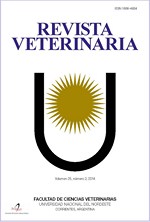Characterization of the citológical profile of the vaginal mucous during the estral cycle in the Santa Inês sheep
DOI:
https://doi.org/10.30972/vet.3326182Keywords:
Sheep Santa Inés, Estral cycle, Vaginal mucous, Citological profileAbstract
The objective of the work was to characterize the cycle of the vaginal epithelium of sheep of the Santa Inês breed, through a cytological study. Vaginal mucosal samples were taken from 10 sexually mature ewes, from the first day of estrus and for 18 days. The samples were stained with Papanicolaou and observed under an optical microscope. Parabasal, de epintermediate, superficial intermediate, and superficial cells were recognized. The parabasal cells presented a rounded shape, little cytoplasm, and a large nucleus, they were scarce. The deep intermediate ones with rounded edges, more abundant cytoplasm, and smaller nuclei. They were observed in greater quantity than the parabasal ones. The superficial intermediate ones were the most abundant through out the study and the one swith the largest diameter. They presented a polygonal shape and a smaller nucleus. The identification of two types of intermediate cells coincides with works on dogs, cows, and alpacas, while other works describe a single type. Superficial cells were divided into two subtypes, A, with a polygonal shape and piknotic nucleus, and B, with a smaller and intensely acidophilic cytoplasm and pyknotic nucleus. The latter has not been found so far in other works with sheep. Changes in cell types did not accurately reflect the phase of the estrous cycle.Downloads
References
Ahmadi M, Nazifi S. 2006. Evaluation of reproductive status with cervical and uterine cytology in fat-tailed sheep. Comp Clin Pathol 15: 161-164.
Brown P. 1944. Physiological and histological changes in the vagina of the of the cow during the estrual cycle. AJVR 5: 15, 99-112.
Correia F.et al. 2010. Identificaçao da ciclicidadeem cabras leiteiras da Raça Saane natravés da citologia vaginal no Município de Venturosa. X Jornada de Ensino, Pesquisa e Extensao, Recife, Brasil.
DeCastro T, Menchaca A, Rubianes E. 2015. Fisiología reproductiva y control del desarrollo folicular en ovejas y cabras. En: Fisiología y tecnologías reproductivas en pequeños rumiantes, Fund. URAU e Instit. Reprod. Anim., Uruguay, 90 p.
Fernández FM, Puig I. 2002. Claves para el diagnóstico dermo-patológico. Toxicodermias. Piel 17: 2, 73-80.
Flamini M, Barbeito G, Portianski E. 2016. Características de la citología exfoliativa en hembras gestantes y no gestantes de Lagostomus maximus. Cs Morfol 18: 1, 10-19.
Hussin A. 2006. The vaginal exfoliative cytology of Awassi ewes during post-parturient period. Iraqui Journal Vet. Med. 30: 2, 130-137.
Macedo PR, Vasconcelos T, Ferreira F, Moreira J, Torres J. 2007. Perfil citológico vaginal de ovelhas da raça Santa Inês no acompanhamento do ciclo estral. Ciencia Animal Brasileña 8: 3, 521-527.
Ola S, Sanni A, Egbunike G. 2006. Exfoliative vaginal cytology during the oestrus cycle of West African Dwarf goats. Reprod Nutr Dev 46: 87-95.
Olhagaray HR. 2004. Comparación de cuatro protocolos de sincronización de celo en vacas Holstein Ovsynch. Tesis de Grado, Universidad Autónoma G.R.Moreno, Santa Cruz de la Sierra, Bolivia, 44 p.
Ovando N, Orihuela A, Flores F, Aguirre V. 2013. Citología y análisis morfométrico de las células del epitelio vaginal durante el ciclo estral en ovejas de pelo (Ovisaries). Int J Morphol 31: 3, 888-893.
Pacheco J. 2017. Caracterización de la citología exfoliativa vaginal en alpacas (Vicugna pacos). Rev Investig Perú 28: 4, 886-893.
Raposo R, Silva L. 1999. Comparaçao qualitativa de diferentes técnicas de coloraçao para citología vaginal de cabras da raça Saanen. Rev Ciên 9: 2, 81-85.
Rezende L. 2006. Perfil citológico vaginal e dinámica folicular durante o ciclo estral em novhila Nelore. Tesis de Maestría, Univ. Federal Goiâs, Brasil, 47 p.
Rosciani A, Merlo W, Macció O. 2006. Citodiagnóstico en pequeños animales. Edit. Univ., Universidad Nacional del Nordeste, Corrientes, Argentina, 66 p.
Sanger V, Engle P, Bell D. 1958. The vaginal cytology of the ewe during the estrous cycle. AJVR 19: 283-287.
Schutte A. 1967. Canine vaginal cytology-I. Technique and cytological morphology. JSAP 18: 301-306.
Schutte A. 1967. Canine vaginal cytology II. Cycly changes. JSAP 8: 307-311.
Tamalatzi C, Ahuantzi M. 2013. La citoquímica aplicada para la determinación de fases del ciclo reproductivo en perras. Trabajo Final de Graduación. Universidad Autónoma Agraria Antonio Narro. Torreón, México, 43 p.
Toniollo G, Monreal A, Laura I, Salazar W, Delfini A. 2005. Citología vaginal em cabras alpinas com CIDR® e eCG. Archivos de Zootecnia
: 208, 634-637.
Widiyono I, Putri P, Sarmin A, Airin C. 2011. Serum estradiol and progesterone concentration, vulva appearance, and exfoliative vaginal cytology during estrous cycle in Biglon goats. Journal Veteriner 12: 4, 263-268.
Zohara B, Azizunnesa IF, Alam G, Bari F. 2014. Exfoliative vaginal cytology and serum progesterone during the estrous cycle of Indigenous ewes in Bangladesh. Journal of Embryo Transfer 29: 2, 183-188.
Downloads
Published
How to Cite
Issue
Section
License
Revista Veterinaria (Rev. Vet.) maintains a commitment to the policies of Open Access to scientific information, as it considers that both scientific publications as well as research investigations funded by public resources should circulate freely without restrictions. Revista Veterinaria (Rev. Vet.) ratifies the Open Access model in which scientific publications are made freely available at no cost online.











.jpg)
.jpg)



